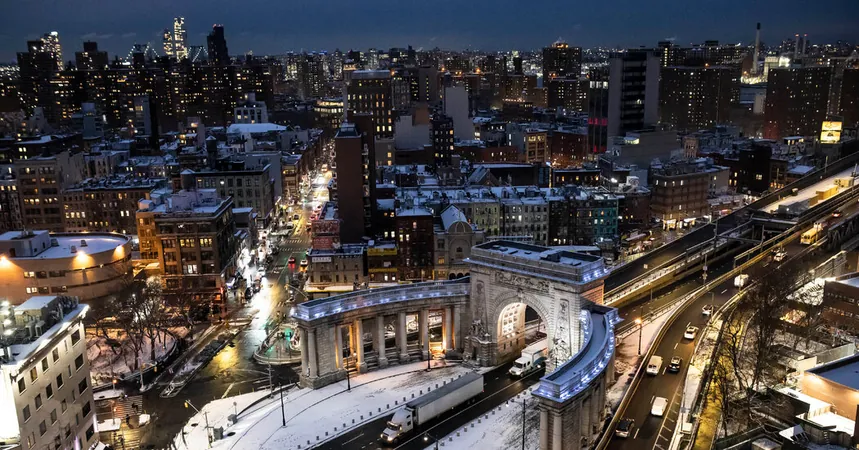
A Promising Start: New York City’s Congestion Pricing Scheme Shows Early Benefits
2025-01-13
Author: Ming
Introduction
In the first week of New York City's groundbreaking congestion pricing initiative, early data indicates a significant reduction in traffic congestion. As tens of thousands fewer vehicles entered the core of Manhattan, the scheme has successfully alleviated gridlock in some of the city's most iconic areas, including Times Square and the Empire State Building.
Traffic Reduction Statistics
Launched on a Sunday with typically lighter traffic, the real challenge arrived with the return to work on Monday. According to the Metropolitan Transportation Authority (MTA), weekday traffic entries into the zone decreased by approximately 7.5% compared to average commute days in January prior to implementation. Notably, traffic on Sunday saw an 18.5% decline. Overall, this translates to around 43,800 fewer vehicles each day, totaling roughly 219,000 fewer vehicles per week.
Reactions from Authority Figures
Janno Lieber, MTA chairman and CEO, expressed optimism about the congestion pricing impact, stating, "People are experiencing a much less traffic-congested environment. Streets are moving more efficiently, there is less noise, and the tension around tunnels and bridges has diminished." The initial results suggest that the ambitious plan, the first of its kind in the U.S., may be on its way to significantly enhancing traffic flow and generating critical funding for transit improvements.
Concerns and External Factors
However, there are still questions about how much this decrease in traffic is attributable to the new tolling structure and how much is influenced by external factors, such as the unusually cold weather during the initiative's rollout. Many experts, including former city traffic commissioner Samuel I. Schwartz, have remarked that while the first week has shown promise, the program's long-term success will depend on sustained changes in commuter behavior.
Predictions and Travel Time Improvements
Predictions suggested that overall traffic in the congestion pricing zone could decline by 13% over the next year. Indeed, MTA statistics reveal that several major bridges and tunnels saw quicker travel times, with westbound trips on the Williamsburg Bridge speeding up by 45% compared to the previous year's averages.
Commuter Experiences
Many commuters have already benefitted from shorter travel times. Josh Castro, a 28-year-old construction manager, reported reducing his commute from Montclair, NJ, to Manhattan to just 40 minutes—down from the usual 75 minutes. Yet, some drivers, like Tony O'Reilly, remain skeptical, attributing lighter traffic to post-holiday conditions rather than a permanent change.
Persistent Congestion and Public Transport Trends
While traffic improved in some areas, congestion persisted in specific streets, particularly along West 42nd Street and Ninth Avenue. As for alternative transport, data on subway and bus ridership is still inconclusive. The MTA's Express buses, however, have reported a 6% increase in ridership, suggesting a positive shift in commuter preferences. For example, the SIM24 bus showcased a travel time reduction in the Lincoln Tunnel by seven minutes compared to last year.
Conclusion and Future Outlook
Early assessments posit that congestion pricing may serve as a model for other cities across the U.S. aiming to tackle traffic woes and bolster public transport use. The urban landscape continues to evolve, and while the journey toward easing congestion is far from complete, the first week's results have ignited hope for a more efficient and sustainable commuting future in New York City.
As congestion pricing progresses, the city and transit authorities will be closely watching its long-term effects and public reception as a harbinger for potential reforms in other metropolitan areas. Will New York's bold leap into congestion pricing become a nationwide trend? Only time will tell!
 Brasil (PT)
Brasil (PT)
 Canada (EN)
Canada (EN)
 Chile (ES)
Chile (ES)
 Česko (CS)
Česko (CS)
 대한민국 (KO)
대한민국 (KO)
 España (ES)
España (ES)
 France (FR)
France (FR)
 Hong Kong (EN)
Hong Kong (EN)
 Italia (IT)
Italia (IT)
 日本 (JA)
日本 (JA)
 Magyarország (HU)
Magyarország (HU)
 Norge (NO)
Norge (NO)
 Polska (PL)
Polska (PL)
 Schweiz (DE)
Schweiz (DE)
 Singapore (EN)
Singapore (EN)
 Sverige (SV)
Sverige (SV)
 Suomi (FI)
Suomi (FI)
 Türkiye (TR)
Türkiye (TR)
 الإمارات العربية المتحدة (AR)
الإمارات العربية المتحدة (AR)